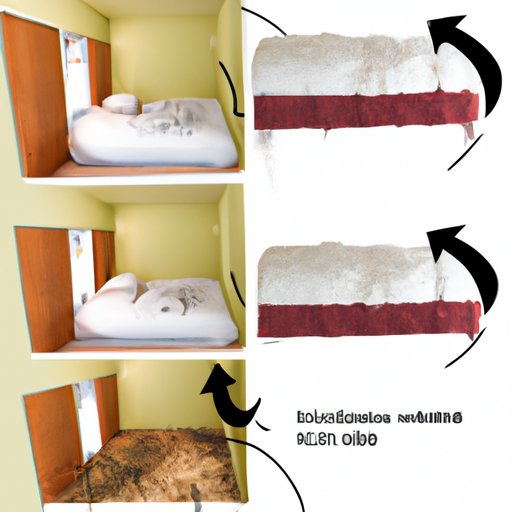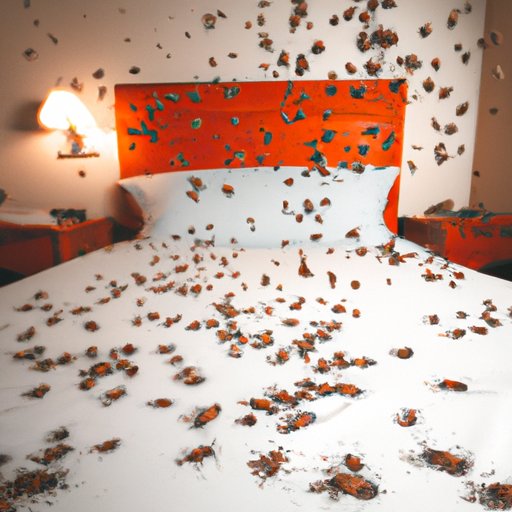
Introduction: Overview of Bed Bugs and Their Ability to Travel
Bed bugs are small, parasitic insects that feed on human blood. They are most active at night and hide during the day in mattresses, box springs, bed frames, and other furniture around beds. Although they cannot fly or jump, bed bugs are excellent hitchhikers and can be easily transported from place to place via clothing, luggage, furniture, and other items.
The presence of bed bugs in one room of a home can be problematic enough, but when they start to spread to other rooms, it can quickly become an overwhelming issue. In this article, we’ll explore the evidence regarding bed bug migration and examine the potential for bed bugs to travel from one room to another.
Examining the Evidence: Can Bed Bugs Move from One Room to Another?
When it comes to understanding how bed bugs move from one location to another, there are two main types of bed bug migration to consider: active and passive. Active migration occurs when bed bugs use their own locomotion to move between locations, while passive migration involves the transportation of bed bugs on objects like clothing or furniture.
So what does the evidence suggest about bed bug movement between rooms? According to research, bed bugs can and do migrate between rooms in both active and passive ways. Studies have found that bed bugs will often travel up to 20 feet in search of a new host and can also move through walls and ceilings in multi-unit dwellings.
Understanding How Bed Bugs Spread: Can They Travel from Room to Room?
Given their ability to travel, the question then becomes: What are the potential sources of bed bug infestations in multiple rooms? In some cases, bed bugs may be brought into a home on used furniture or clothing, or they may be spread by visitors who unknowingly carry them from one location to another.
It’s also important to note that bed bugs can spread from one room to another within the same dwelling. For example, bed bugs could travel from a bedroom to an adjacent living room or kitchen. In multi-unit buildings, bed bugs can even spread from one unit to another via shared walls, floors, and ceilings.

Exploring the Potential for Bed Bug Migration Between Rooms
When it comes to understanding the potential for bed bug migration between rooms, there are several factors to consider. First, the size of the infestation is important. The larger the infestation, the more likely it is that bed bugs will spread to other areas of the home.
In addition, bed bug movement is strongly influenced by human activity. For example, bed bugs are more likely to spread when people are moving around the house, carrying items from one room to another, or sleeping in different beds.
Isolation Tactics: Best Practices for Limiting Bed Bug Migration
If you have an active bed bug infestation in one room, it’s important to take steps to limit their movement to other areas of the home. One of the best ways to do this is to isolate the infested area by sealing off all entrances and exits with heavy-duty plastic sheeting.
In addition, using physical barriers such as double-sided tape or sticky traps around doorways and windows can help prevent bed bugs from entering or leaving the room. Finally, installing interceptor cups beneath bed and furniture legs can help capture any bed bugs that try to crawl out of the room.

Prevention Tips for Keeping Bed Bugs Out of Other Rooms in Your Home
The best way to keep bed bugs out of other rooms in your home is to practice preventive measures. This includes regularly inspecting your home for signs of bed bugs, vacuuming frequently, and laundering bedding, curtains, and other fabrics in hot water.
It’s also important to reduce clutter in your home, as clutter provides more hiding places for bed bugs. Finally, if you’re buying used furniture or clothing, inspect it carefully for signs of bed bugs before bringing it into your home.
Conclusion
Bed bugs are highly adept at traveling from one room to another, so it’s important to be aware of the potential for them to spread. By taking proactive measures to reduce risk and isolating infested areas, you can help limit the movement of bed bugs and keep them from spreading to other rooms in your home.
(Note: Is this article not meeting your expectations? Do you have knowledge or insights to share? Unlock new opportunities and expand your reach by joining our authors team. Click Registration to join us and share your expertise with our readers.)
